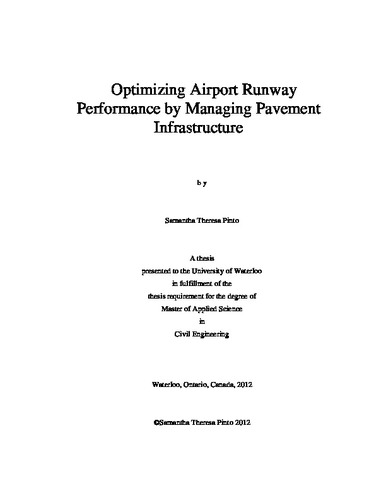| dc.contributor.author | Pinto, Samantha Theresa | |
| dc.date.accessioned | 2012-08-29 15:42:52 (GMT) | |
| dc.date.available | 2012-08-29 15:42:52 (GMT) | |
| dc.date.issued | 2012-08-29T15:42:52Z | |
| dc.date.submitted | 2012 | |
| dc.identifier.uri | http://hdl.handle.net/10012/6903 | |
| dc.description.abstract | The research described herein is composed of four major areas of practice. It examines the overall performance of runways and provides tools designed to improve current runway operations and management with particular emphasis on contaminated surfaces.
Presented in this thesis is an overview of how to design airport pavements in order to achieve optimal friction by specifically focusing on material selection and construction techniques for rigid and flexible pavements. Rubber buildup and the impact rubber accumulation has on decreasing runway friction, particularly in a range of climatic conditions, is discussed. Four commonly used rubber removal techniques are presented and evaluated. Through this research, an analytical hierarchy process (AHP) decision making protocol was developed for incorporation into airport pavement management systems (APMS).
Runway surface condition reporting practices used at the Region of Waterloo International Airport are evaluated and recommendations for improving current practices are identified. Runway surface condition reporting can be improved by removing subjectivity, reporting conditions to pilots in real time, standardizing terminology and measurement techniques, and including runway pictures or sketches to identify contaminant locations where possible. Reports should be incorporated and stored in the APMS.
Aircraft braking systems and their effects on landing distances under contaminated conditions are discussed. This thesis presents a proposed solution for monitoring and measuring contaminated runway surfaces and identifying the risks associated with aircraft landing through using the Braking Availability Tester (BAT). Also proposed in this thesis is a testing framework for validating the Braking Availability Tester. The proposed BAT measures interaction between aircraft antiskid braking systems and runway contaminants to determine landing distances more accurately.
Finally, this thesis includes a discussion explaining how pavement design, contaminant removal, results from friction tests, and results from the BAT can be incorporated into airport pavement management systems. APMS data can be analyzed to economically optimize and prioritize scheduling of pavement maintenance, preservation and rehabilitation treatments to maintain a high level of service, thereby contributing to runway safety and optimization. | en |
| dc.language.iso | en | en |
| dc.publisher | University of Waterloo | en |
| dc.subject | Infrastructure | en |
| dc.subject | Pavement | en |
| dc.subject | Pavement Management | en |
| dc.subject | Airport | en |
| dc.subject | Runway Design | en |
| dc.subject | Runway Contaminants | en |
| dc.subject | Infrastructure Management | en |
| dc.subject | Braking Availability | en |
| dc.subject | Contaminant Removal | en |
| dc.subject | Airport Pavement Management System | en |
| dc.subject | Optimizing Performance | en |
| dc.subject | Civil Engineering | en |
| dc.subject | Airport Engineering | en |
| dc.subject | Pavement Engineering | en |
| dc.subject | Airport Design | en |
| dc.subject | Pavement Design | en |
| dc.subject | Runway Monitoring | en |
| dc.subject | Runway Reporting | en |
| dc.subject | Canadian Runway Friction Index | en |
| dc.subject | analytical hierarchy process | en |
| dc.title | Optimizing Airport Runway Performance by Managing Pavement Infrastructure | en |
| dc.type | Master Thesis | en |
| dc.pending | false | en |
| dc.subject.program | Civil Engineering | en |
| uws-etd.degree.department | Civil and Environmental Engineering | en |
| uws-etd.degree | Master of Applied Science | en |
| uws.typeOfResource | Text | en |
| uws.peerReviewStatus | Unreviewed | en |
| uws.scholarLevel | Graduate | en |

